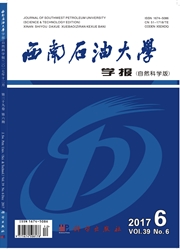

 中文摘要:
中文摘要:
针对当前钻柱系统黏滑振动产生的影响不断增大的问题,研究黏滑振动的自激振动特性。通过建立钻柱系统的黏滑振动力学模型,推导了钻头于黏滞阶段与滑脱阶段的状态方程,并得到其滑脱阶段的振动响应。在得到系统黏滑振动特性的基础上,研究钻头在不同初始条件时相对转盘运动的相轨迹。结果表明,当钻头初相点存在扰动时,其运动均将趋向于稳定的黏滑振动,表现为钻头运动的相轨迹收敛于稳定的极限环。对黏滑振动产生的原因进行分析,结果表明,产生黏滑振动的钻柱系统在黏滞状态与滑脱状态转变时均存在摩擦扭矩的降落,相当于在钻头转动方向作用一个外载,即钻头临界状态转变时存在的负阻尼效应将钻柱的振动调节为自激振动。
 英文摘要:
英文摘要:
Stick-slip vibrations in drill string systems appear to generate effects that increase continuously over time.To address this issue,we studied the characteristics of self-excited oscillations that occur during stick-slip vibrations.By constructing a mechanical model for stick-slip vibrations in drill string systems,we have derived state equations to describe a drill in its sticking and slipping stages and obtained the oscillatory response of the drill during its slipping stage.Based on the characteristics of stick-slip vibrations in drill string systems,we then studied the phase trajectory of the relative rotary motion of a drill in varying initial conditions.The results indicate that a perturbation in the initial phase point of the drill will result in motions that trend toward a stable form of stick-slip vibration.This manifests as a phase trajectory that converges to a stable limit cycle.We also analyzed the reasons underlying the generation of stick-slip vibrations,and found that drill string systems undergoing stickslip vibrations always display a decrease in friction torque during the transition between sticking and slipping states,which is equivalent to the application of an external load in the direction of rotation of the drill.In other words,the negative damping effect that is present during the critical state transition of a drill changes the vibrations of the drill string into self-excited oscillations.
 同期刊论文项目
同期刊论文项目
 同项目期刊论文
同项目期刊论文
 期刊信息
期刊信息
